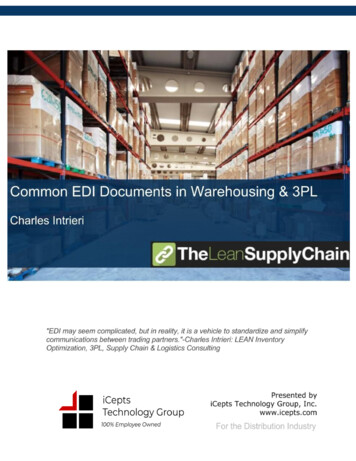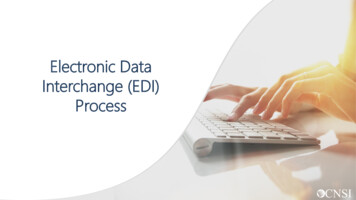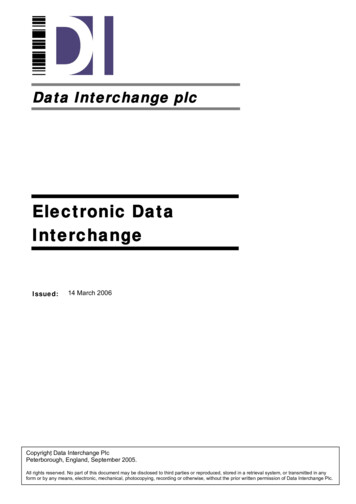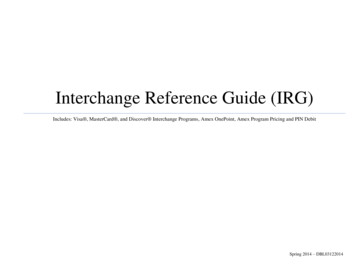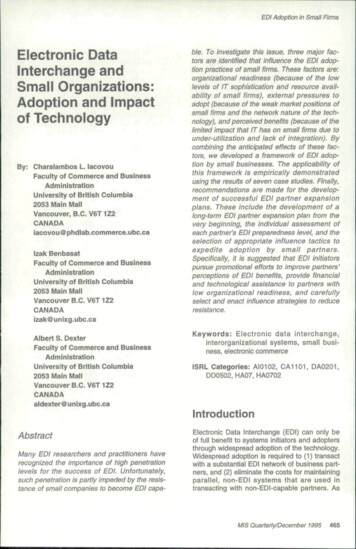
Transcription
EDi Adoption in Smalt FirmsElectronic DataInterchange andSmall Organizations:Adoption and Impactof TechnologyBy: Charalambos L. lacovouFaculty of Commerce and BusinessAdministrationUniversity of British Columbia2053 Main MallVancouver, B.C. V6T 1Z2CANADAiacovou@phdlab.commerce.ubc.caIzak BenbasatFaculty of Commerce and BusinessAdministrationUniversity of British Columbia2053 Main MallVancouver B.C. V6T 1Z2CANADAizak@unixg.ubc.caAlbert S. DexterFaculty of Commerce and BusinessAdministrationUniversity of British Columbia2053 Main MallVancouver B.C. V6T1Z2CANADAaldexter@unixg.ubc.cable. To investigate this issue, three major factors are identified that infiuence the EDi adoption practices of smaii firms. These factors are:organizationai readiness (because of the lowieveis of iT sophistication and resource avaiiabiiity of smaii firms), externai pressures toadopt (because of the weak market positions ofsmaii firms and the network nature of the technoiogy}, and perceived benefits (because of thelimited impact that iT has on small firms due tounder-utiiization and iack of integration). Bycombining the anticipated effects of these factors, we deveioped a framework of EDi adoption by smaii businesses. The applicability ofthis framework is empiricailydemonstratedusing the resuits of seven case studies. Finaiiy.recommendations are made for the deveiopment of successful EDi partner expansionplans. These inciude the deveiopment of along-term EDI partner expansion pian from thevery beginning, the individual assessment ofeach partner's EDi preparedness ievel, and theselection of appropriate influence tactics toexpediteadoptionby smaiipartners.Specificaiiy, it is suggested that EDi initiatorspursue promotionai efforts to improve partners'perceptions of EDi benefits, provide financiaiand technoiogicai assistance to partners withiow organizationai readiness, and carefuiiyseiect and enact infiuence strategies to reduceresistance.Keywords: Electronic data interchange,interorganizational systems, small business, electronic commerceISRL Categories: At0102, CA1101, DA0201,DD0502, HA07. HA0702IntroductionAbstractMany EDi researchers and practitioners haverecognized the importance of high penetrationlevels for the success of EDi. Unfortunateiy,such penetration is partiy impeded by the resistance of smaii companies to become EDi capa-Electronic Data interchange (EDI) can only beof full benefit to systems initiators and adoptersthrough widespread adoption of the technology.Widespread adoption is required to (1) transactwith a substantial EDi network of business partners, and (2) eliminate the costs for maintainingparallel, non-EDt systems that are used intransacting with non-EDI-capable partners. AsMIS Ouarteriy/December 1995465
EDI Adoption in Small Firmsa critical mass of firms become EDI-capable,the costs of trade transactions will decrease forEDI users, who will be able to more efficientlyprocess the majority, if not all, of their purchases, sales, and payments via EDI (Bouchard,1993; Lyttle, 1988; McCusker, 1993).One major impediment to this level of adoptionis the inability of EDI initiators to motivate theirbusiness partners to adopt the technology. Thisis especially true for small enterprises that arereluctant to join the EDI community (Ahlin,1991; Banerjee and Golhar, 1994; Smith,1990). The lack of EDI capability of small organizations is critical because of the importantrole they play in the economy.' To address thisissue, many large organizations, industry associations, and governmental units have recentlylaunched EDI partner expansion plans.However, many practitioners have argued that"expanding trading partners seems more difficult than implementing EDI in the first place"(Stelzer, 1993, p. 43). Because of the importance of high adoption levels, this reluctance ofsmaller partners to become EDI-capabledeserves serious attention.Thus, this article addresses two issues;(1) What are the major factors that influence theadoption and impact of EDI in the small business context, and (2) how can EDI systems initiators assist in expediting the adoption processof their small partnera?To examine these issues, we reviewed past conceptual and empirical research on EDI adoptionand impact, formulated a small business-focusedEDI-adoption framework, and tested its validitywith seven case studies. A summary of the literature review, a description of the model of EDIadoption by small businesses, an overview ofour research methodology, a summary of theempirical findings, a iist of recommendations toEDI initiators, and a description of suggestionsfor future research comprise this article.Literature ReviewElectronic data interchangeexchange structured business information electronically between separate computer applications (Swatman and Swatman, 1992). lOSs aretelecommunication-based computer systemsthat are used by two or more organizations tosupport the sharing of data, and sometimesapplications, among users in different organizations (Barrett and Konsynski, 1982; Cash, 1985).For an lOS to be classified as EDI, it must possess four essential features (Pfeiffer, 1992):1. It must have at least two organizations in abusiness relationship as users;2. Data processing tasks pertaining to a transaction at both (all) organizations must besupported by independent application systems, (This property is unique to ED); otherlOSs are based on a single application system that is used by multiple users.)3. The integrity of the data exchange betweenapplication systems of trading partners mustbe guaranteed by agreements concerningdata coding and formatting rules; and4. Data exchange between the application systems must be accomplished via telecommunication links.EDI adoptionMost of the past EDI studies have used the diffusion of innovations theory (Rogers, 1983) toidentify attributes of the innovation (the EDIsystems) that influence its adoption. Among themost commonly investigated EDI characteristics that promote the adoption of the technologyare: relative advantage (i.e., perceived EDIbenefits and impact), compatibility (both technical and organizational), and trialability {e.g.pilot tests, prototypes, etc.).2 Perceived relativeadvantage of EDI Is the only variable that hasbeen consistently identified as one of the mostcritical adoption factors and as the most important factor for information technology (IT)growth In small fimns (Cragg and King, 1993).Therefore, perceived EDI benefits wereEDIs are co-operative interorganizational systems (lOS) that allow trading partners to466MIS Quarterly/December 1995included in our framework as one of the mainexplanatory factors for EDI adoption.
EDI Adoption in Smaii FirmsSeveral factors that inhibit EDt adoptions werealso identified. Among these are the cost andcomplexity of the technology, the need tochange internal systems, a lack of technologicalskills, and a lack of system integration (Pfeiffer.1992; Saunders and Clark, 1992). We expectthese inhibitors to play a big role in the contextof smaii organizations, where resources andcomputer sophistication are limited {Swatmanand Swatman, 1991). Indeed, empirical findingssuggest that economic costs and iack of technical knowledge are two of the most importantfactors that hinder IT growth in small organizations (Cragg and King. 1993). Therefore, EDIorganizational readiness, defined as the availability of the needed organizational resourcesfor adoption, is another factor in this study.Clearly, many factors influence the adoption ofEDI.3 But, since these factors have generallybeen identified through studies of large organizations, their applicability to small business is questionabie. Smaller organizations have been shownto have different technology adoption patternsthan large ones.-' Furthermore, most of the previous studies failed to recognize that EDI is a network interorganizationai system in which interdependencies, power of the EDI initiator, and trusttoward the partners become critical issues. Pressure from trading partners who are EDI initiators plays a critical role in EDI adoption bysmall firms (Hart and Saunders, 1994; Swatmanand Swatman, 1991; Webster, 1994). Researchsuggests that a firm's decision to adopt EDI "isprimarily based on what [its] business partnersare doing and not on the characteristics of EDI"{Bouchard, 1993, p. 366). Indeed, more than 70percent of the respondents in recent surveysidentified customer pressure/mandate as one ofthe primary reasons for adopting EDL Hence,external pressure to adopt EDI is an additionalfactor in our framework.A Model of EDI Adoption bySmall BusinessesBased on a review of the iiterature on EDIadoption and small business IT, three factors —(1) perceived benefits of EDI, (2) organizationalreadiness, and (3) external pressure — wereidentified as the main reasons that couldexplain the EDI adoption behavior of small firmsand the expected impact of the technology. Thereiationships of these factors with the processof EDI adoption and integration, and impact areshown in Figure 1.OrganizationalReadinessEDI AdoptionandIntegrationFigure 1. Proposed Small Business EDI Adoption ModelMIS Quarterly/December 1995467
EDi Adoption in Smaii FirmsEDI adoption and integrationPerceived EDI benefitsEDI adoption is the process during which a firmbecomes capable of transacting via EDI, usuallythrough a front-end, PC-based EDI server. Thisis the first step of EDI integration. Although adoption and integration can be undertaken at thesame time, EDI integration is the process duringwhich a firm aiters its business practices andapplications so that they interface with its EDIapplications. For the purposes of this study, integration is considered bi-dimensional. Intemaiintegration refers to the variety of applicationsinterconnected through EDI, such as order-entry,invoicing, billing, and payment transfer, andexternai integration refers to the number of trading partners, such as suppliers, customers, governmental units, and financial institutions withwhich the firm can transact business through EDI(Bergeron and Raymond, 1992).Many practitioners and researchers haveattempted to identify the potential advantagesthat EDI technology has to offer.' These can begrouped into two categories (Pfeiffer, 1992),roughly equivalent to the two levels of integrationnoted above. The first group is direct benefits.These are mostly operational savings related tothe internal efficiency of the organization. Thesecond group is indirect benefits or opportunities.which refer to the Impact of EDI on the businessprocesses and relationships. These are mostlytactical and competitive advantages. A list of thetwo types of benefits is presented in Table 1.EDI impactImpact refers to the actuai benefits adoptersreceive from utilizing EDI. To estimate theexpected impact of the technology, the level ofsystem integration is used as a sun-ogate measure. We assume that the integration level cf EDIis positively related to the benefits an adoptercan receive given its EDI capability {Benbasat, etal., 1993; Bergeron and Raymond, 1992;Bouchard, 1993). Usually, non-integrated EDIsystems will offer adopters direct benefits only,such as reduced transaction costs and higherinformation quality. Integrated systems, on theother hand, will offer both high direct benefitsand the ability to take advantage of indirect benefits, such as increased operational efficiency,better customer service, and improved interfirmrelationships. This more complete integration,which requires interorganizational design andpolicies, is essential to achieve the performanceimprovements and full beneficial Impact of EDI(Clark and Stoddard, 1994).468MIS Ouarteriy/December 1995Although direct benefits can include large financiaisavings, much of the attention on EDI has focusedon its impact on business operations. EDI offersseveral opportunities that can tum into organizationai advantages if they are combined with anappropriate business strategy and reengineeringof business processes (Clark and Stoddard, 1994;Swatman, et al., 1993). This means that EDI isideally best integrated with the core business ofthe organization, since higher levels of integrationlead to higher expected benefits.Perceived EDI benefits refer to the level ofrecognition of the relative advantage that EDItechnology can provide the organization.f Higher managerial understanding of the relativeadvantage of EDI (i.e., direct and indirect benefits) increases the likelihood of the allocation ofthe managerial, financial, and technologicalresources necessary to implement an integrated EDI system (Benbasat, et a l . , 1993).Therefore, we anticipate that small firms withmanagement that recognizes the benefits ofEDI wiil be more iikeiy to adopt EDi and enjoyhigher impacts than those whose managementhas a iower ievel of recognition of the perceivedbenefits.Organizational readiness for EDIOrganizational readiness refers to the level of(1) financial and (2) technological resources ofthe firm. This factor was considered becausesmall firms tend to lack the resources that are
EDI Adoption in Small FirmsTable 1. List of Benefits Accrued to EDI Users*BenefitsDirect Benefits:Reduced transaction costsImproved cash flowReduced inventory levelsHigher information qualityIndirect Benefits (Opportunities):Increased operational efficiencyBetter customer serviceimproved trading partner relationshipsIncreased ability to competeReasonsElimination of papenwork; labor savingsFaster processing and exchange ofinformationShorter order cycle; reduced orderingcostsIncreased timeliness, accuracy, andaccessibility of informationImproved intemai operations due to timeand cost reduction and better informationmanagementShorter lead times; more timety Informationabout transaction statusEnhanced trust through increased sharing ofinformation; elimination of nuisance factors (e.g.enrors in orders); increased ability to participatein Just-in-Time programsIncreased ability to reach new markets;increased ability to provide better service at alower cost'Based on a list of benefits in Pfeiffer (1992).necessary for EDI and other IT investments(Bouchard, 1993; Saunders and Clark, 1992).Furthermore, the relatively low computerizationlevel of the operations of small firms makes theintegration of sophisticated information systems(such as EDI) difficult, necessitating costlyexpenditures (i.e., capital, people, and technology). Because smail organizations tend to lacksuch resources, their ability to receive all strategic benefits of the technology is usually limited.Financial readiness refers to financial resourcesavailable for EDI to pay for installation costs,implementation of any subsequent enhancements, and ongoing expenses during usage(such as communication charges, usage fees,etc.). Although the cost of EDI adoption can belimited to a few hundred dollars (for EDI software running on a front end, independent personal computer), the cost of integration may njnover 10,000 (Bouchard, 1993). Because integration Is necessary for successful EDI investments, one can easily see the importance offinancial resources. Usually, small firms withavailable financial resources wiil be betterequipped to implement integrated EDI systems.Consequently, firms that can afford more costly,integrated EDI projects are more likely to enjoyhigher benefits from the use of such systems.The second dimension of organizational readiness—technological readiness—is concernedwith the level of sophistication of IT usage andIT management in an organization.Sophisticated finms usually are less likely to feelintimidated by the technology, possess a superior corporate view of data as an integral part ofoverall information management, and haveaccess to the required technological resources(i.e., hardware, expertise, and a competent project leader) (Pare and Raymond, 1991). Weexpect that these properties of sophisticatedfirms will expedite EDI adoption. Moreover,firms with highly integrated, computerizedprocesses are better prepared to undertakeintegrated EDI projects, which increase theimpact of the technology and provide greaterbenefits. In summary, we anticipate that smallMIS Ouarteriy/December 1995469
EDi Adoption in Small Firmsfirms with higher organizationai readiness forEDI wiil be more likely to be adopters and morelikely to enjoy higher benefits than firms withlow levels of readiness.Extemal pressure to adopt EDIExternal pressure to adopt refers to influencesfrom the organizational environment. The twomain sources of external pressure to adopt are(1) competitive pressure, and more importantiy, (2) imposition by trading partners, such aswhen U.S. car manufacturers required theirsuppliers to use EDI in their transactions withthem. Competitive pressure refers to the levelof ED! capability of the firm's industry and,most importantly, to that of its competitors. Asmore competitors and trading partnersbecome EDI-capabie, small firms are moreinclined to adopt EDI in order to maintain theirown competitive position.Imposition from trading partners is expected tobe one of the most critical factors for EDIadoption by smaii firms; as the weaker partners in interorganizationai relationships, smallbusinesses are extremely susceptible to impositions by their larger partners (Saunders andHart, 1993). Such impositions are especiallyprevalent in the case of EDI because of itsnetwork nature.The pressure exercised by trading partners isa function of two factors: the potential power ofthe imposing partner and its chosen infiuencestrategy (Provan, 1980). Not surprisingly,requests from powerful partners (e.g., onesthat consume a large proportion of sales orgenerate a large portion of the smaii firm'sprofits) to become EDl-capable are expectedto be more influential in the adoption decisionof small firms than similar requests from lesspowerfui partners.A powerful partner may pursue three differentstrategies to induce a small partner to adoptEDI.9 In the first type of strategy—recommendations—large firms use information to altertheir smaller trading partners' general perceptions of how their organizations might moreeffectively operate via the use of EDI. In con-470MIS Ouatierty/December 1995trast, the other two strategies require compliance from the smaller firms. Promises includeall tactics that suggest that the larger firm willprovide the smaller partner with a specifiedreward (such as discounts for EDI-transactedgoods, subsidized adoption and usage, etc.) ifit becomes EDl-capable. Threats, on the otherhand, refer to actions that convey the largerfirm's intentions to apply negative sanction(such as discontinuance of the partnership)should the smaller company fail to becomeEDl-capable. Such threats have been invokedby large automobile manufacturers anddepartment store chains in recent years(Brent, 1994).Because of the importance of external integration in EDI networks, one expects small organizations to be more vulnerable to competitivepressures and more likely to comply withdemands of their trading partners than largerfirms (Pfeffer and Salancik, 1978). Thus, weexpect that smail firms that encounter pressure either by their partners or from the competition wiii adopt EDi more frequently thanthose that do not encounter such pressure.As outlined in Table 2, we expect perceivedbenefits and organizational readiness to infiuence both the adoption and integration (andthus impact) of EDI. External pressure, on theother hand, is expected to play a critical role inthe adoption decision, but not in integration.Research MethodologyTo investigate the effects of the three mainfactors, an empiricai study of seven companies was undertaken during the Summer of1993.10SampleAlt seven organizations In our sample are suppliers to the British Columbia (BC) government,which is currently pursuing an EDI initiative.These companies were selected from a list ofprovincial government suppiiers with less than
EDI Adoption in Smaii FirmsTable 2. Summary of Concepts, Variables, and Expected RelationshipsConceptVariablesExpected EffectEDI AdoptionCapability to transact via EDIEDI IntegrationInternal integrationExternal integrationEDI ImpactActual direct and indirectbenefits receivedPerceived BenefitsAwareness of direct benefitsAwareness of indirect benefitsOrganizational ReadinessExtemal PressureFinancial resourcesTechnological resourcesCompetitive pressureImposition by partners200 employees; the list was provided by the BCPurchasing Commission (BCPC)." These BCgovemment suppliers are currently the target ofan EDI implementation plan as part of the BCBuy Smart project, a major initiative undertakenby the government in an attempt to streamlineand computerize its purchasing function. The EDiproject is currently in development and scheduledto become functional by 1996. Although anattempt was made to identify small companiesthat were EDI-capable and include them in thesampie, only two of the seven were EDi-capable.This lack of small EDI-capable companies furthersupports the initial arguments about the reluctance of small firms to adopt EDI.After the seven companies were identified aspotential candidates, high-ievel managers (owners, vice presidents, or other top-level managers)were asked to participate in the study. Aii of themagreed tc participate. A summary description ofthese companies is presented in Tc le 3.Positively related toadoption, integration, andimpactPositively related toadoption. Integration, andimpactPositively related toadoptionfirms were conducted to supplement the infonnation gathered during the personal interviews.Three firms also provided a copy of their financialstatements. Ail interviews were tape recorded,and all sessions were transcribed before the datawere analyzed. To enhance the validity of theanswers, summaries of the major findings of eachinterview were verified by the participants afterthe end of each interview session. Furthermore,to ensure consistency and reliability, structuredinterview guides were used for all interviews. Twoforms of the interview guide were developed—one for non-EDI-capable and one for EDI-capable firms. 2 The interview guides included severalopen fonriat questions to allow the participantsflexibility in their responses.Empirical FindingsCategories of EDI adoptersData collectionThe main data collection method was face-toface, structured interviews with managers of thesmall organizations. However, when necessary,telephone interviews with other executives in theThe relative proportions of organizational readiness, extemai pressure, and perceived benefits ina firm influence different levels of ED! adoptionand impact for the organization. Thus, we combined the anticipated effects of each factor to for-mulate a framework to serve as an EDIMiS Quarterly/December 1995471
4728CO Q151-MIS Quarterly/December 1995E "3COo4)o 0inCMtoCOCMa.UJUJ T3CUJCTctomonioooCOtoeo1.eortg—8CMcucaeuo a. n sCO o1ly largeOtn"EouS)— adis tributorsCOT3(0customerand sma; paperistriibutors;Uo oOan-timeVeryf w, largemultin lionalcotpoi tionsCOfpOl itionsFew;' iry largeVeryl ge firms 0.3Engin sring/manui Ct. Oflow te nnologyproduID a —3.sYesctnFew largmultinatiiand man localproducer Df large an1 fimis; boand abro.CO.1—ELarge equipmFew large irms;suppliers; tale ted one suppi s60%artistsof produciZ«iny; mostlyfirmsinLarge su ermarichains ai dsmalrestauraiOl4,000 cus imers;large andoryf ew iargi0One larg firm afew smai ones(0IDCOODl-CTotappliers( Q.CDLarge privategovemmentalcorporationsCOBin! and osmall firmCTC COistomers010)str"BAbout 7; allsmall firmsu'r-a.impetitoio iiom 18.5"OCDnviironmentO.en iO5oo oloyeestnmercialrinti3X3CC C1 vegetabi1g[rialcle am ngand:ingcatsoand"oc: CDProcessiwhotesala.«Officefumituresales; mocontract s lesCDale sin 199(CDr J miliio ns)Businesscommun., vk*and printproductionr-IBSFinnEDI Adoption In Small FirmsCDo2ogenzozo"eoCJu a enCD c"rezOinco1Q.COUJ
EDI Adoption in Small FirmsUnprepared Adoptersadoption/impact typology for small businesses(see Table 4). We investigated the proposedmodel by classifying each of the organizations inour sample according to this framework (seeTable 5). This section describes and illustrateseach organizational type from Table 4 as it appliesto the case study organizations. Then, a fuller discussion of the effects of the factors is offered.Unprepared adopters are firms that are pressured into adopting EDI by their trading partners. Even though these finns are aware of thepotential benefits of the technology, they do notpossess the necessary financial resourcesand/or technical expertise to integrate the EDITable 4. Franfiework of EDI Adoption by Small HighOrganization12345EDI InitiatorHighHigh6aNon-AdopterHighLowLowN/A6bN ble 5. Summarized Case inessHighHighLowHighHighLowLowDependency on LowBC GovernmentLowHighLowLowHighHighWillingness toAdopt BC BuySmartHighHighHighLowHighHighLowThe entry for firm 2 Indicates the current integralion level of its EDI applications; for the rest of the firms, It indicates expected levels.MIS Quarterly/December 1995473
EDi Adoption in Small Firmssystem into their operations (i.e., they lackorganizational readiness). In the case of adoption due to imposition by a trading partner, EDImay help to enhance the trading relationship,but it will not significantly Improve the internalprocesses of the adopter firm because lowreadiness indicates a lack of needed resourcesto develop an integrated EDt system that wouldprovide high benefits.One organization in our sample (firm 7) is likelyto become an unprepared adopter if it attemptsto adopt EDI without any assistance. Firm 7 is alow-technology engineering firm run by one person. Its level of IT sophistication is very low. Itowns two personal computers and no facsimile,all of its operations are manual (except for theuse of a simple accounting program), and theowner has very little computer experience. Ithas limited financial resources; its annual salesare 250,000. and its working capital is about 15,000. Even though the owner recognizedseveral benefits that EDI can offer to her organization (such as time and cost savings), sheindicated that a lack of resources restrains herfirm's ability to become EDI-capable. Despitethe lack of these resources, the owner hasexpressed a strong willingness to become EDIcapable as part of the BC Buy Smart projectbecause she thinks that an EDI partnership willimprove her trading relationship with the government. This relationship is very important forthe survival of her firm because it Is currentlytrying to sign a new, major contract with the BCgovemment, the largest of its seven clients.Firm 2, an office furniture retailer, is a readyadopter. It had a high level of preparednessbefore adopting an EDI system; it owned amainframe, had many personal computers, andemployed an MIS staff of five. Overall, Its operations were highly computerized and integrated. This high level of IT sophistication was augmented by support subsidies from the tradingpartner that initiated the EDI adoption. Thistrading partner, which supplies 60 percent offirm 2's purchases, was wholly responsible forthe EDI installation, maintenance, and stafftraining. The high level of organizational readiness of finn 2 enabled the implementation of ahighly integrated system. Characteristically, thissystem included software that transformed thesalespeople's layout designs into orders thatwere then transmitted via EDI. According to therespondent, this integrated system reduced theneed for order entry clerks, eliminated errors,and significantly improved customer service.Having recognized the large benefits that EDIcan offer, the management is currently attempting to establish EDI partnerehips with its othersuppliers and customers. In our opinion, highlevels of preparedness and awareness of benefits account for the willingness of this firm toparticipate tn the BC Buy Smart project, despiteits extremely low dependency on governmentbusiness (less than three percent of its salesare made to the BC government).Coerced AdoptersReady AdoptersReady adopters represent those organizationsthat, although pressured into an EDI relationship, are prepared for it. They usually have thenecessary resources to develop Integrated EDIsystems that will interface with their existingcomputer applications. Management of readyadopter firms has recognized the relativeadvantages of EDI and is willing to allocate therequired resources and support the adoption ofEDI in the organization. This, in turn, wouldsuggest the eventual implementation of an integrated EDI system with many benefits.474MIS Ouarteriy/Decemher 1995Coerced adopters are small firms that are pressured into adopting EDI without having recognized the need for it and without owning thenecessary resources to integrate the technology. Even though coerced adopters are not fullyaware of the potential impact of the technology,they adopt EDI to sustain the business relationship with the imposing trading partner.However, it is very common that coerced, smalladopters can afford only a stand-alone personalcomputer as an EDI server. In such cases, theEDI system is no more beneficial than a fax ore-mail-based system. Consequently, the potential efficiency of EDI does not materialize.
EDI Adoption in Small FirmsTwo companies in our sample, firms 3 and 6,lack necessary resources to adopt but are highly dependent on the BC government. Thesefirms are likely to become coerced adopterswho would not realize the full benefits of thetechnology unless the BC government provi
Electronic data interchange EDIs are co-operative interorganizational sys-tems (lOS) that allow trading partners to exchange structured business information elec-tronically between separate computer applica-tions (Swatman and Swatman, 1992). lOSs are telecommunication-based computer systems that are used by two or more organizations to
